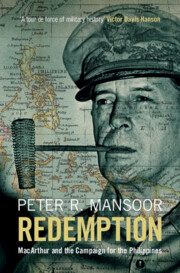Refine search
Actions for selected content:
3 results

Redemption
- MacArthur and the Campaign for the Philippines
-
- Published online:
- 14 August 2025
- Print publication:
- 14 August 2025
5 - Leyte Gulf
-
- Book:
- Redemption
- Published online:
- 14 August 2025
- Print publication:
- 14 August 2025, pp 174-220
-
- Chapter
- Export citation
4 - The Decision
-
- Book:
- Redemption
- Published online:
- 14 August 2025
- Print publication:
- 14 August 2025, pp 147-173
-
- Chapter
- Export citation
